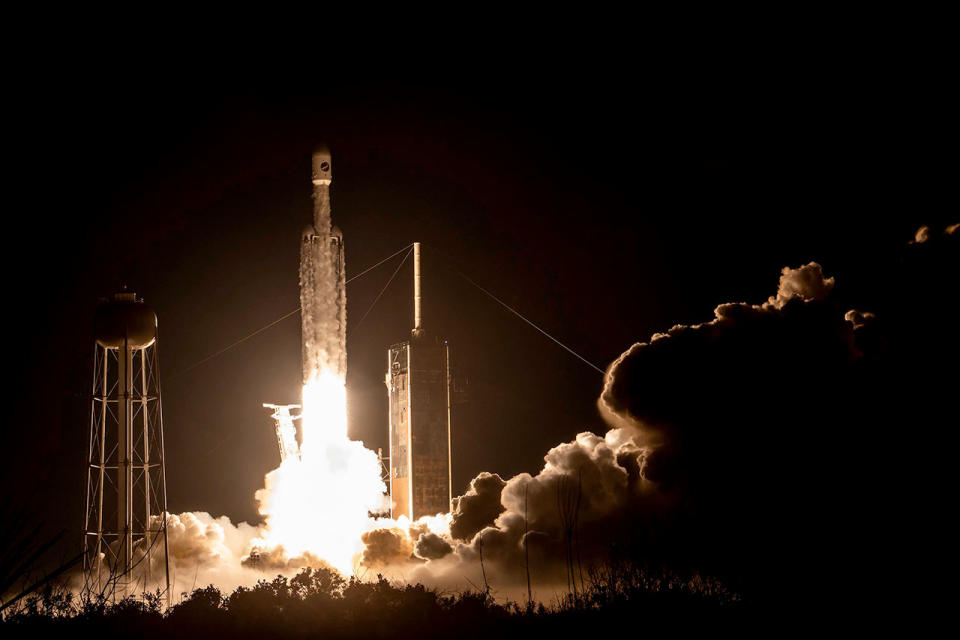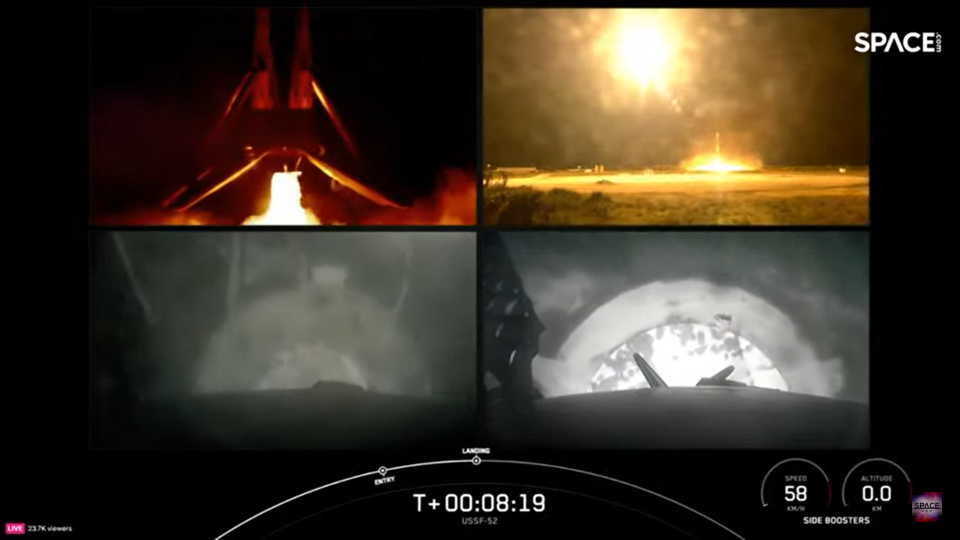The US military’s X-37B space plane has finally embarked on its latest secret mission.
The robotic X-37B lifted off atop a SpaceX Falcon Heavy rocket from NASA’s Kennedy Space Center (KSC) in Florida on Thursday night (December 28) at 8:07 pm EST (0107 GMT on December 29) after weeks of delays. SpaceX’s first two attempts to launch the secret X-37-B military space plane earlier this month were delayed by bad weather and a ground equipment issue.
Thursday’s launch was the seventh liftoff for the X-37B to date but its first ride on SpaceX’s Falcon Heavy, the second most powerful rocket currently in operation (after NASA’s Space Launch System). It was SpaceX’s 95th launch in 2023, with the next just hours away when a Falcon 9 rocket will launch 23 Starlink satellites from the Cape Canaveral Space Force Station at 11:01 pm EST (0401 GMT).

SpaceX shut down its live stream of the Falcon Heavy launch before deploying the X-37B space plan into its final orbit at the request of the US Space Force.
The new X-37B mission, called OTV-7 (“Orbital Test Vehicle-7”) as well as USSF-52, will apparently benefit from the rocket’s muscle; the main objectives of the flight “include the operation of the reusable space plane in new orbital regimes,” Space Force officials wrote in a mission preview last month.
Related: The US Space Force’s secret X-37B space plane: 10 surprising facts


The Falcon Heavy consists of three modified and strapped together first stages of a working SpaceX Falcon 9 rocket. The second stage is attached to the central booster in this line-up, which also carries the payload.
The Heavy’s three first stages are reusable, as we saw during today’s liftoff: The two outer boosters returned for a safe touchdown at the Cape Canaveral Space Force Station, which is next door to KSC, approx. at 8.5 minutes after takeoff. It was the fifth launch and landing for the two boosters, which also includes the launch of NASA’s Psyche asteroid probe, which flew last October.
“We successfully landed both Falcon Heavy side boosters at Landing Zone 1 and Landing Zone 2,” Jessie Anderson, SpaceX’s mechanical production and engineering manager, said in a live webcast. “With these two side boosters, this is the 257th and 258th successful landings overall on an orbital-class rocket.”
The Heavy’s central booster flew for the first time today; It deliberately sank into the Atlantic Ocean after launch, having consumed too much of its fuel to return to Earth for recovery and reuse.


The X-37B looks like NASA’s retired space shuttle but is much smaller. The unmanned vehicle is only 29 feet (8.8 meters) long, with a wingspan of 15 feet (4.6 m). In contrast, each shuttle orbiter was 122 feet (37 m) long and had a wingspan of more than 78 feet (24 m).
The Space Force is thought to have two X-37B vehicles, both built by Boeing. The space planes are used primarily as orbital test beds, allowing the military to see how instruments perform and behave in the space environment. We don’t know much about this gear; details about X-37B missions, from their flight plans to the main payloads, are usually classified.
For example, the Space Force only targets OTV-7 in broad areas. In addition to the “new orbital regime” goal, the flight will “expand the United States Space Force’s knowledge of the space environment by testing future space domain awareness technologies,” Space Force officials wrote in the mission report. “These tests are essential to ensure safe, stable and secure operations in space for all users of the domain.”
Not everything that pulls the space plane into orbit, however; it also usually picks up some civilian equipment. For example, a NASA experiment called Seeds-2 is traveling on OTV-7.
Seeds-2 will “expose plant seeds to the harsh radiation environment of long-duration spaceflight,” wrote Space Force officials. The project will build on the success of previous experiments, paving the way for future manned space missions,” they said.
RELATED STORIES:
— X-37B: Space’s mysterious space plane
— The US Space Force’s secret X-37B space plane: 10 surprising facts
— SpaceX Falcon Heavy rocket sends NASA’s Psyche probe to strange metal asteroid (video)
It’s unclear how long OTV-7 will last, but it’s safe to assume the spaceplane will be around for a while. The previous six X-37B missions lasted more than seven months each, and each exceeded the duration of its predecessor:
-
OTV-1: 224 days (launched on April 22, 2010, landed on December 3, 2010)
-
OTV-2: 468 days (launched on March 5, 2011, landed on June 16, 2012)
-
OTV-3: 674 days (launched on December 11, 2012, landed on October 17, 2014)
-
OTV-4: 718 days (launched on 20 May 2015, landed on 7 May 2015)
-
OTV-5: 780 days (launched on September 7, 2017, landed on October 27, 2019)
-
OTV-6: 908 days (departed on May 17, 2020, landed on November 12, 2022)
All six previous missions flew in low Earth orbit, just a few hundred miles above our planet. The Falcon Heavy could take the X-37B much higher, possibly all the way to geosynchronous orbit, about 22,000 miles (35,000 kilometers) up. But it is not clear if that is the plan for OTV-7.
The first five X-37B flights were achieved atop a United Launch Alliance Atlas V rocket. SpaceX provided launch services for the most recent two: OTV-6 flew on Falcon 9 and OTV-7 on Trom.
The Falcon Heavy debuted in February 2018 with a long-awaited test flight that sent SpaceX founder and CEO Elon Musk’s red Tesla Roadster into orbit around the sun. The big rocket now has nine flights under its belt, including five in 2023.